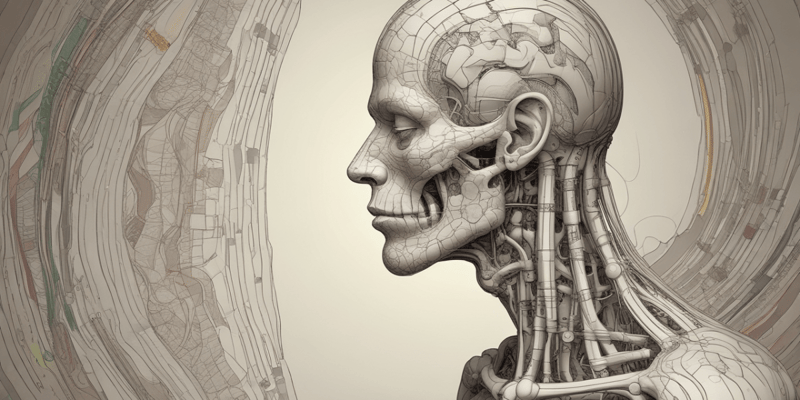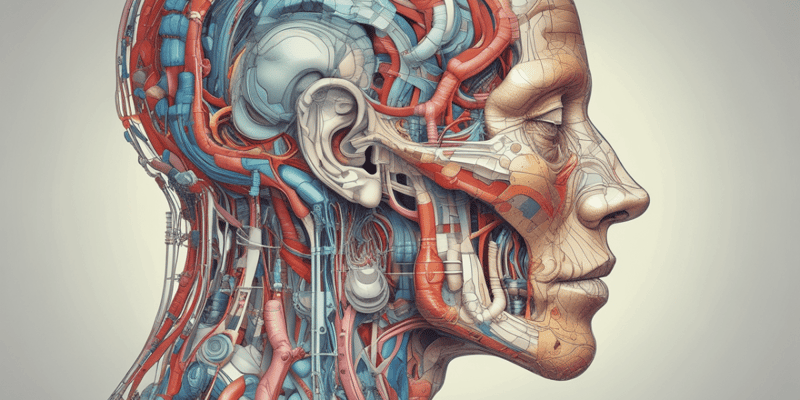Podcast
Questions and Answers
What is the primary function of the cristae ampullaris in the vestibular system?
What is the primary function of the cristae ampullaris in the vestibular system?
What is the role of the maculae in the vestibular system?
What is the role of the maculae in the vestibular system?
What innervates the maculae and cristae ampullaris?
What innervates the maculae and cristae ampullaris?
What is the effect of gravity on the vestibular hair cells?
What is the effect of gravity on the vestibular hair cells?
Signup and view all the answers
What is the sequence of the 3 ossicles in the middle ear that transmit vibrations from the tympanic membrane to the inner ear?
What is the sequence of the 3 ossicles in the middle ear that transmit vibrations from the tympanic membrane to the inner ear?
Signup and view all the answers
Which of the following is NOT a central connection of the vestibular system?
Which of the following is NOT a central connection of the vestibular system?
Signup and view all the answers
What is the membrane that separates the perilymph and endolymph in the cochlear duct?
What is the membrane that separates the perilymph and endolymph in the cochlear duct?
Signup and view all the answers
What is the structure responsible for converting mechanical sound stimuli into nerve impulses in the auditory system?
What is the structure responsible for converting mechanical sound stimuli into nerve impulses in the auditory system?
Signup and view all the answers
What is the pathway through which the remaining pressure waves in the scala tympani are dissipated?
What is the pathway through which the remaining pressure waves in the scala tympani are dissipated?
Signup and view all the answers
What is the nerve that conveys the nerve impulses from the cochlea to the auditory cortex?
What is the nerve that conveys the nerve impulses from the cochlea to the auditory cortex?
Signup and view all the answers
What is the region of the brain where the auditory pathways terminate and sound is perceived?
What is the region of the brain where the auditory pathways terminate and sound is perceived?
Signup and view all the answers
What is the primary function of the vestibulo-ocular pathway?
What is the primary function of the vestibulo-ocular pathway?
Signup and view all the answers
How do the corresponding ducts on opposite sides of the head function?
How do the corresponding ducts on opposite sides of the head function?
Signup and view all the answers
What happens when the duct/canal of one side is stimulated?
What happens when the duct/canal of one side is stimulated?
Signup and view all the answers
What is the relationship between the horizontal ducts of opposite sides of the head?
What is the relationship between the horizontal ducts of opposite sides of the head?
Signup and view all the answers
What is the result of the activity generated by the semicircular canals?
What is the result of the activity generated by the semicircular canals?
Signup and view all the answers
Which extraocular muscles are stimulated by each semicircular canal?
Which extraocular muscles are stimulated by each semicircular canal?
Signup and view all the answers
What direction do the eyes move when the right horizontal canal is stimulated?
What direction do the eyes move when the right horizontal canal is stimulated?
Signup and view all the answers
Which muscles are responsible for moving the eyes upward and to the left when the right anterior canal is stimulated?
Which muscles are responsible for moving the eyes upward and to the left when the right anterior canal is stimulated?
Signup and view all the answers
What is the direction of eye movement when the right posterior canal is stimulated?
What is the direction of eye movement when the right posterior canal is stimulated?
Signup and view all the answers
Which nuclei are primarily responsible for controlling horizontal and vertical eye movements?
Which nuclei are primarily responsible for controlling horizontal and vertical eye movements?
Signup and view all the answers
What is the primary function of the vestibulo-ocular reflex?
What is the primary function of the vestibulo-ocular reflex?
Signup and view all the answers
Which direction is the head rotated when the right posterior canal is stimulated?
Which direction is the head rotated when the right posterior canal is stimulated?
Signup and view all the answers
Which visceral motor functions are regulated by the vestibuloreticular pathway?
Which visceral motor functions are regulated by the vestibuloreticular pathway?
Signup and view all the answers
What is the primary function of the vestibuloreticular pathway?
What is the primary function of the vestibuloreticular pathway?
Signup and view all the answers
Which of the following is an example of the vestibuloreticular pathway in action?
Which of the following is an example of the vestibuloreticular pathway in action?
Signup and view all the answers
What is the purpose of the doll's eye test?
What is the purpose of the doll's eye test?
Signup and view all the answers
How is the doll's eye test performed on an unconscious patient?
How is the doll's eye test performed on an unconscious patient?
Signup and view all the answers
What is the normal response to the doll's eye test?
What is the normal response to the doll's eye test?
Signup and view all the answers
Study Notes
Vestibular System
- Consists of receptors, vestibular nerve, and central connections
- Receptors: cristae ampullaris and maculae
- Innervated by CN VIII (vestibular nerve)
- Classified into dynamic receptors and static receptors
- Stimulus: position or changes in the position of the head
Auditory System
- Pathway of sound: sound waves enter the external ear, causing the tympanic membrane to vibrate
- Vibrations transmitted to the inner ear through the oval window via the 3 ossicles: malleus, incus, and stapes
- Pressure waves generated in the perilymph travel across the vestibular membrane to the endolymph of the scala media
- Basilar membrane ripples, causing the bending or displacement of hair cells in the Organ of Corti
- Mechanical sound stimulus converted into a nerve impulse
- Nerve impulses conveyed along the cochlear nerve, terminating in the auditory area of the temporal lobe of the central cortex
Vestibulo-Ocular Pathway
- Formed by the connection of the vestibular nuclei to the extraocular motor nuclei in the brainstem
- Main function: prevent slipping of the image from the fovea centralis during head movements
- Corresponding ducts on opposite sides of the head that lie in the same plane function in pairs
- Stimulation of one duct inhibits the duct on the opposite side
- Each semicircular canal stimulates a yoked pair of extraocular muscles that move the eyes in the same plane as the canal
Vestibulo-Reticular Pathway
- Projection of the vestibular nerve to the reticular formation through its connection to the reticular activating system
- Fibers come from the lateral and inferior vestibular ganglia and terminate on the reticular activating system and various visceral motor nuclei
- Projections are mainly ipsilateral
- Regulates visceral motor functions such as vomiting, coughing, cardiovascular functions, respiration, and speech function
Doll's Eye Test
- Aka Oculocephalic test
- Procedure used to elicit the vestibulo-ocular reflex
- Can be done to conscious and unconscious patients
- Examiner holds the eyelids with thumb and index finger and rotates the head from side to side while assessing eye movement
- Normal response: eyes move opposite to the head
Studying That Suits You
Use AI to generate personalized quizzes and flashcards to suit your learning preferences.
Description
Test your knowledge on the pathway of sound in the auditory system, from the external ear to the inner ear, including the transmission of vibrations through the ossicles and the journey of pressure waves through the cochlear duct. Learn about the different components involved in this process. Evaluate your understanding of the auditory system and its functions.




